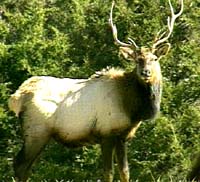Pest Not Grave Concern For KY Elk Population
Pest Not Grave Concern For KY Elk Population

A pest native to the Commonwealth is drawing attention because of its appearance in the relatively-new elk population. But, University of Kentucky College of Agriculture specialists say the meningeal worm, more commonly referred to as the brain worm, is not cause for alarm.
"This is nothing new, the brain worm was here 150 to 200 years ago when elk were here before," said David Maehr, UK's principle investigator for research in the elk restoration project. "We are very concerned about diseases and because of that we are screening for all the ones we don't want to be introduced into Kentucky."
Before an elk comes to the bluegrass state, it has to go through a battery of blood tests, while staying in quarantine for a week. The blood is examined for things such as brucellosis, tuberculosis, chronic wasting disease (similar to mad cow disease), etc. Once the samples are thoroughly examined and skin tests are read, the elk is fitted with a radio transmitter collar and put on a truck to Kentucky.
The brain worm originates in mollusks, such as snails or slugs and then reaches adulthood in the brains and nervous systems of white-tail deer. The deer have evolved to be resistant to any effects of the parasite. It grows in and around their brain and spinal cord, and the deer show no signs of distress.
Elk, on the other hand, have not evolved to resist the brain worm and the symptoms of infection can include blindness, general neurological damage, lethargy, etc.
"The result is not always death; we have seen some that have apparently survived it (brain worm)," Maehr said. "But we've also been able to confirm some have died from it. It's just going to take time to get the answers and we're in the process of doing that right now."
Maehr said on-going projects at UK and Clemson are addressing the parasite. A doctoral student is studying the brain worm life cycle to see if there are ways of managing it in such a way that it reduces the likelihood for elk to be infected.
"We are guessing the parasite is found more in the forests than grasslands," Maehr speculated. "That would strongly suggest that if elk stay mainly in grassland habitats, they will be less likely to come in contact with the brain worm."
Maehr said this summer, researchers will try to get radio transmitters on new born calves and follow them until they mature or die. That way, they can get in there as quick as possible after death to determine the cause. This will help us see if younger animals are more susceptible than mature adults.
The mortality rate of re-introduced elk is very small. Most of the animals are adapting and reproducing well in their new home. The ultimate goal of the Kentucky Fish and Wildlife Department in the elk restoration project is to have a huntable population that will bring in license revenue and provide new opportunities for hunters.
"The first hunting season will actually be this fall," Maehr said. "A couple permits will be auctioned off at high prices and the money raised will go back into the project."
The project started in 1997 in an effort to bring elk back to the state. The animal had been gone for nearly two centuries. Kentucky plans to bring in 1800 elk before the transporting process is complete. Kentucky is part of many eastern and southern states restoring elk populations including Tennessee, Virginia, North Carolina, Arkansas, Wisconsin, and Michigan.